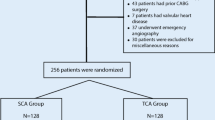Abstract
The aim of this study was to compare the radiation dose to patients during coronary angiography (CA) and coronary intervention (percutaneous transluminal coronary angioplasty, PTCA) by the femoral or radial artery access routes. A plane-parallel ionisation chamber, mounted on an under-couch X-ray tube (Siemens Coroskop TOP with an optional dose reduction system), recorded the dose-area product (DAP) to the patient from 40 coronary angiographies and 42 coronary interventions by the femoral route. The corresponding numbers for radial access were 36 and 24, respectively. Using a human-shaped phantom, conversion factors between maximum entrance surface dose and DAP were derived for CA and CA plus PTCA, respectively. The dose to the staff was measured with TL dosimeters for 22 examinations. Fluoroscopy time and DAP were significantly (p=0.003) larger using the radial access route for coronary angiography (7.5 min, 51 Gy cm2) than the corresponding values obtained from femoral access route (4.6 min, 38 Gy cm2). For CA plus PTCA the fluoroscopy time and DAP were larger for radial access (18.4 min, 75 Gy cm2) than for femoral access (12.5 min, 47 Gy cm2; p=0.013). In our experience, radial access did significantly prolong the fluoroscopy time and increase the patient doses.

Similar content being viewed by others
References
Kiemeneij F, Laarman GJ, Odekerken D, Slagboom T, van der Wieken R (1997) A Randomized comparison of percutaneous transluminal coronary angioplasty by the radial, brachial and femoral approaches: the access study. J Am Coll Cardiol 29:1269–1275
Koenig TR, Wolff D, Mettler FA, Wagner LK (2001) Skin injuries from fluoroscopically guided procedures. Part I: Characteristics of radiation injuries. Am J Roentgenol 177:3–11
Koenig TR, Mettler FA, Wagner LK (2001) Skin injuries from fluoroscopically guided procedures. Part II: Review of 73 cases and recommendations for minimizing dose delivered to patients. AJR 177:13–20
Wagner LK, Eifel PJ, Geise RA (1994) Potential biological effects following high X-ray dose interventional procedures. J Vasc Intervent Radiol 5:71–84
Fransson S-G, Persliden J (2000) Patient radiation exposure during coronary angiography and intervention. Acta Radiol 41:142–144
Ross RD, Joshi V, Carravallah DJ, Morrow WR (1997) Reduced radiation during cardiac catheterisation of infants using acquisition-zoom technology. Am J Cardiol 79:691–693
Larsson P, Alm Carlsson G, Persliden J, Sandborg M (1996) Transmission ionization chambers for measurements of air collision kerma integrated over beam area: factors limiting the accuracy of calibration. Phys Med Biol 41:2381–2398
SSI (2002) Comments to the regulations and general advice (SSI FS 2002:2) of the Swedish Radiation Protection Authority on diagnostic standard doses and reference levels within X-ray diagnostics. (URL http://www.ssi.se/forfattning/PDF_Eng/com_2002_2e.pdf)
Hansson B, Karambatsakidou A (2000) Relationship between entrance skin dose, effective dose and dose area product for patients in diagnostic and interventional cardiac procedures. Radiat Proton Dosim 90:141–144
Neofotistou V (2001) Review of patient dosimetry in cardiology. Radiat Proton Dosim 94:177–182
Lobotessi H, Karoussou A, Neofotistou V, Louisi A, Tsapaki V (2001) Effective dose to a patient undergoing coronary angiography. Radiat Proton Dosim 94:173–176
Tapiovaara M, Lakkisto M, Servomaa A (1997) A PC-based Monte Carlo program for calculating patient doses in medical X-ray examinations. STUK-A139, February 1997. (STUK, P.O. Box 14, 00881 Helsinki, Finland; Program version 1.4.1, December 2001)
SSI (2002) The Swedish Radiation Protection Authority’s regulations and general advice on diagnostic standard doses and reference levels within medical X-ray diagnostics. SSI FS 2002:2 (URL http://www.ssi.se/forfattning/PDF_Eng/2002–2e.pdf)
Geijer H, Beckman K-W, Andersson T, Persliden J (2002) Radiation dose optimisation in coronary angiography and percutaneous coronary intervention (PCI). II. Clinical evaluation. Eur Radiol 12:2313–2819
van de Putte S, Verhaegen F, Taeymans Y, Thierens H (2000) Correlation of patient skin doses in cardiac interventional radiology with dose-area product. Br J Radiol 73:504–513
Waite JC, Fitzgerald M (2001) An assessment of methods for monitoring entrance surface dose in fluoroscopically guided interventional procedures. Radiat Proton Dosim 94:89–92
Vano E, Gonzales L, Ten JI, Fernandez JM, Guibelalde E, Macaya C (2001) Skin dose and dose-area product values for interventional cardiology procedures. Br J Radiol 74:48–55
International Commission on Radiological Protection (ICRP) (2000) Annals of the ICRP, publication 85. Avoidance of radiation injuries from medical interventional procedures, vol 30, no. 2, Pergamon, Oxford
Acknowledgements
J. Nilsson-Althén and V. Fransson are acknowledged for performing the quality assurance test measurements on the X-ray equipment, and S. Hellman for performing the reading of TL dosimeters. G. Alm Carlsson is acknowledged for careful reading of the manuscript.
Author information
Authors and Affiliations
Corresponding author
Rights and permissions
About this article
Cite this article
Sandborg, M., Fransson, SG. & Pettersson, H. Evaluation of patient-absorbed doses during coronary angiography and intervention by femoral and radial artery access. Eur Radiol 14, 653–658 (2004). https://doi.org/10.1007/s00330-003-2120-4
Received:
Revised:
Accepted:
Published:
Issue Date:
DOI: https://doi.org/10.1007/s00330-003-2120-4




